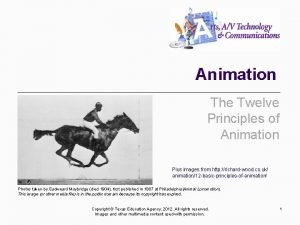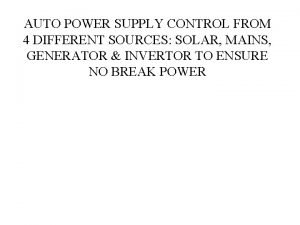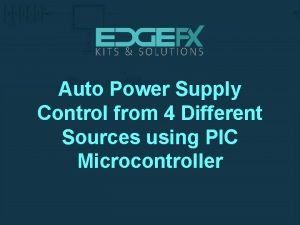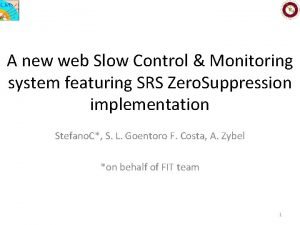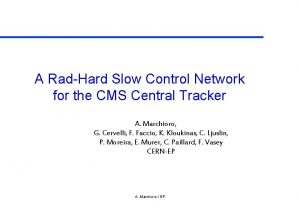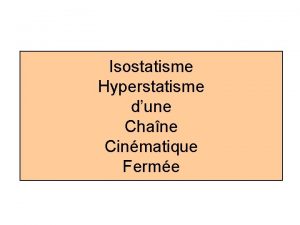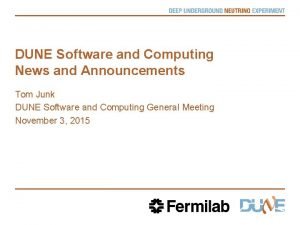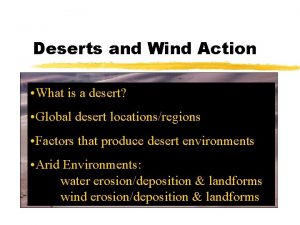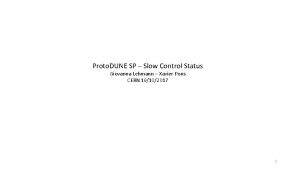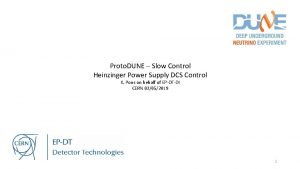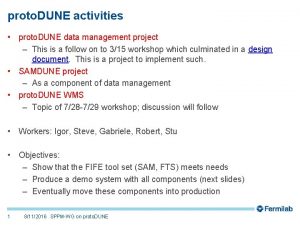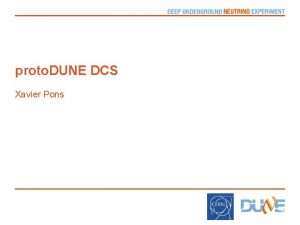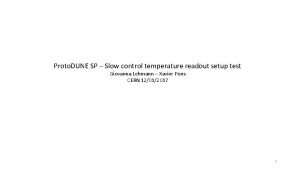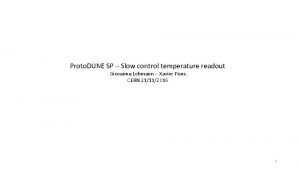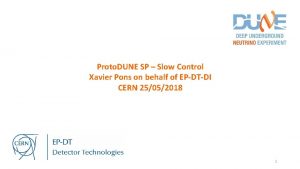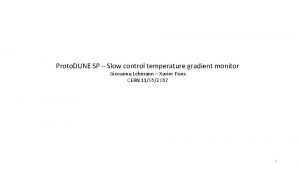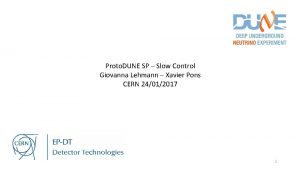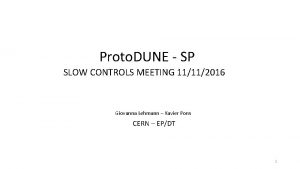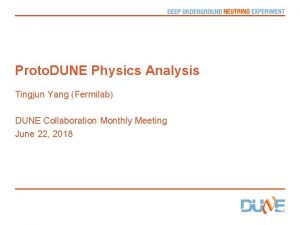Proto DUNE SP Slow Control Heinzinger Power Supply













- Slides: 13

Proto. DUNE SP – Slow Control Heinzinger Power Supply DCS Control X. Pons, A. Kehrli, S. Ravat CERN EP/DT 20/09/2018 1

Heinzinger Technical Data 2

Why using analogue control? 3

HEINZINGUER Sub-D 15 - Analogue control DCS adjusts by voltage: - DCS assigns a U-Ref (Pin 8 -Pin 3) a 0 -10 V =>> 0 -300 k. V AO 0 - DCS reads the I-mon (Pin 1 -3) AI 0 - DCS reads the V-mon (Pin 2 -3) AI 1 Heinzinguer Sub-D 15 signal mapping View Heinzinguer Sub-D 15 signal mapping 4

DCS – Heinzinger control hardware DCS includes a National Instrument c. RIO-FPGA 9039 controller (link) with the following I/O modules 1 - Analogue input module NI 9239 (link) 4 channels ± 10 V 24 -bits 2 - Analogue Output Module NI 9269 (link) 4 channels ± 10 V 16 -bits 3 - Analogue Input Module NI 9220 (link) 16 channels ± 10 V, 100 k. S/s/ch, 16 -Bit (Ground Planes) 4 - DI/DO Module NI 9375 (link) Digital control bits Heinzinguer DCS c. RIO control crate Detail of DCS c. RIO controller 5

DCS – Heinzinger control signals – Low level - Monitor with AI module NI 9239 24 bits over ± 10 V (bipolar) Voltage Monitor 0 - 300 k. V over 0 - 10 V the resolution is 36 m. V Current Monitor 0 – 0. 5 m. A over 0 -10 V the resolution is 0. 06 n. A - Control with AO module NI 9269 16 bits over ± 10 V (bipolar) Voltage Ref (setpoint) 0 - 300 k. V over 0 - 10 V the resolution is 9. 16 V 6

DCS – Heinzinger control Process WINCC DCS - The control process (AI reading/AO writing; voltage setpoint, Current Limit, Current Trip) is executed inside the CRIO-FPGA in a 1 ms loop. - The data is transmitted to Real-Time controller, connected and integrated to the WINCC DCS program by means of the OPC UA driver, allowing the control, operation and survey. - The DCS system provides in 3 different formats the HV status for monitoring and diagnostics DCS slow acquisition OPC UA EVENT log c. RIO Heinzinger Controller AI/AO Hardware signals Fast acquisition Heinzinger Power Supply 7

DCS – Heinzinger control Process - The Heinzinger control is quite simple, it’s an open loop, just applying a Voltage setpoint and defining a specific ramp up d. V/dt. - There are defined 3 states: - Ramping - Steady (nominal) - Trip (Fault, OFF) - For changing from one State to another one, several pre-defined conditions have to be accomplished. - A ramp up/down can be stopped - EMERGENCY STOP button (software and Hardware) implemented and tested. Heinzinger HV DCS Control Panel - Heart beat added in order to check the communication integrity from c. RIO to DCS, useful in case of network loss, tested. - LAr Level at 7200 mm interlock included, (condition to TRIP state) 8

DCS – Heinzinger control Process Current Limit – Dynamic limit - A current threshold/offset is defined above the nominal current, this threshold/offset is also constant during ramping state. - Ilimit(µA) = R(system) x Voltage + C (Offset) - If the Heizinger Current reaches the Ilimit(µA) level then the voltage is automatically adjusted (decreased ) until the Heizinger current is again below the I Limit Heinzinger Control Parameters Current Trip - A current threshold is defined, beyond this limit the Heinziger trips. A time filter can be also defined in order to skip noise spikes. Fastacq threshold file The Heinzinger Current Value is included in the Ground Planes Fast Acquisition 50µs loop with the Ground Planes Voltages and the Beam Plug Current generating a file with those values using a circular buffer with 1 second pre-trigger and 5 seconds after. Certain conditions of the Heinzinger Power Supply events (Current Trip, Current Limit…) are included in the trigger conditions for generating the file. V ramp up (red) with the system Current (Blue) and dynamic Current Limit threshold 9

DCS – Heinzinger Operation Ramp up to 150 k. V – Representative current and voltage spike when the 150 k. V setpoint is reached - It has been observed that the analogue control of the Heinzinger apparently differs from the digital (Ethernet) used in the US in terms of noise, sensitivity an/or integrity of the electrical signals delivered by the Heinzinger Analogue connector. - An intense debate is currently under way with all the actors including the Heinzinger Company in order to verify the accuracy of the data. - A first impression is that the analogue signal seems to be quite “noisy” or the Ethernet control seems more stable. This impression is concluded after the single. Phase power supply was remotely controlled from US via Ethernet. - As example the voltage and current spikes that are shown by the analogue control when the setpoint is reached and not observed with the Digital control. - In the other hand, the analogue control with higher sampling rate (1 ms) than the digital one offers the possibility to observe the events with more accuracy; as example, the current/voltage spikes observed after the voltage setpoint can be attributed to a normal behavior of the Power Supply and its voltage regulation algorithm. (To be confirmed by Heizinger) 10

DCS – Heinzinger Operation Heinzinger 0. 55 µA / 70 V Oscillations at 180 k. V nominal conditions 11

DCS – Heinzinger Operation - The Heizinger Analogue control offers the possibility to apply filter techniques in order to improve the quality of the signal. - A low pass filter with a cutoff frequency 10 Hz is applied to the Voltage signal from the connector and the result is clearly visible in the red plot. - The option applying the same filter techniques to the current value from the connector is already programmed but disabled, awaiting a final decision Lab. View Low Pass Filter configuration tool 12

13
 Slow in slow out animation
Slow in slow out animation Flex power power supply
Flex power power supply Auto power supply control from 4 different sources ppt
Auto power supply control from 4 different sources ppt Auto power supply from 4 different sources
Auto power supply from 4 different sources Slow control application
Slow control application Slow control application
Slow control application Power triangle formula
Power triangle formula Longnitudinal
Longnitudinal Sand dunes definition
Sand dunes definition Climax stage
Climax stage Dune ddl
Dune ddl Dune software
Dune software In the desert, ephemeral streams _____.
In the desert, ephemeral streams _____. Dune sp
Dune sp
